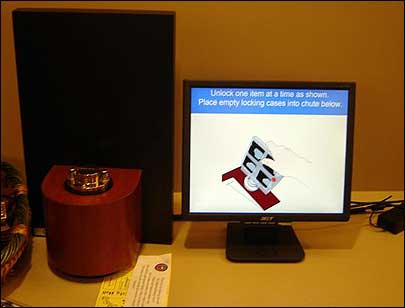When the new library in Fontana—a fast-growing bedroom community in San Bernardino County, Calif.—opens in April, its collection of 150,000 books and other media will carry RFID tags. The library hopes this will reduce theft and staff workloads, while empowering library patrons to check out and return items on their own.
The Integrated Technology Group (ITG), a division of Vernon Library Supplies, will install its Apex RFID technology at the city’s $60 million Lewis Library and Technology Center. The 94,000-square-foot, two-story center will be the city’s largest civic project, and the largest regional library in San Bernardino County.
The Fontana facility will be the fourth branch of the San Bernardino County Library to use ITG’s RFID system—but the largest, by far, says George Fedor, automation coordinator for the library system. “Our primary goal,” he states, “is to enable patron self-service and self-checkout for all materials, giving patrons tools to serve themselves without having to rely so heavily on staff.”
The components of the ITG system include passive, high-frequency tags and interrogators compliant with the ISO 15693 air-interface protocol, as well as ITG’s Apex software, which controls the RFID hardware and provides the requisite platform applications for checking out, returning and sorting books and other materials. Each tag contains an I-Code SLI 13.56 MHz integrated circuit, made by NXP Semiconductors. Fontana library staff will begin applying the tags to each item in the library collection prior to the new building’s opening.
The interrogators will be built into kiosks that patrons will use to borrow items, and also into the library’s book-sorting system. The readers will control the conveyor system to ensure that each returned item is sent to the appropriate bin, based on its shelf location and status. As each item passes the reader, the Apex application will query the library’s back-end circulation database, via an application protocol interface. If the database shows that a request has been made on the item being returned, the conveyor will drop that item at the circulation desk. Otherwise, each book or AV item will be sent to its appropriate sorting bin, used by staff members to reshelf returned items.
The Lewis Library will also utilize RFID as a security tool for books and audio-visual items. As a patron checks out each item, the reader will change a bit saved to the tag’s memory that designates the item as being checked out. (This same bit is re-encoded once the item is returned, changing the item’s status to show that it has been checked in). Interrogators mounted at each library exit read the item tags. If they detect an item that has not been checked out, Apex triggers an audio alert. Security guards stationed at the exit will then request that the patrons carrying the item return to the checkout station to check it out.
For AV media items, such as DVDs and CDs, ITG is building an additional security tool into the Fontana branch system. ITG provides locking plastic cases to hold these media items, many of which—particularly recent movies or music releases—are subject to high levels of theft. Patrons wishing to borrow locked media items are instructed, via a video monitor at each self-checkout kiosk, to first check out each item and then insert the media case into an unlocking device. The unlocking device, controlled by the Apex software, will not unlock an item unless the item has been checked out.
Audio-visual items can comprise up to 35 percent of library collections, says Amy Thropp, ITG’s product manager. As such, protecting those items from theft is vital. Locked media cases, she says, dissuade theft by making the discs very difficult to access.


